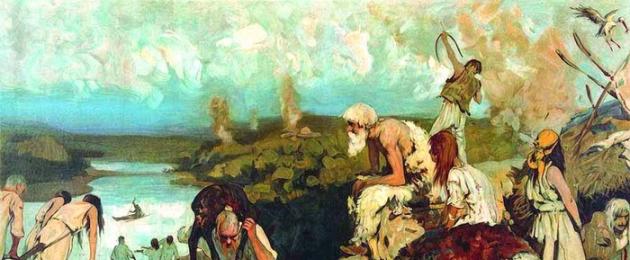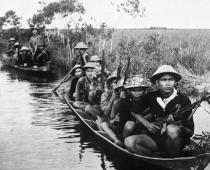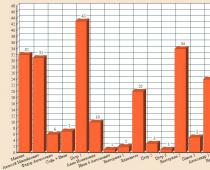Starting a conversation about the Eastern Slavs, it is very difficult to be unambiguous. There are practically no sources that tell about the Slavs in antiquity. Many historians come to the conclusion that the process of the origin of the Slavs began in the second millennium BC. It is also believed that the Slavs are a separate part of the Indo-European community.
But the region where the ancestral home of the ancient Slavs was located has not yet been determined. Historians and archaeologists continue to debate where the Slavs came from. Most often it is asserted, and Byzantine sources speak about this, that the Eastern Slavs already lived in the territory of Central and Eastern Europe in the middle of the 5th century BC. It is also believed that they were divided into three groups:
Wends (lived in the Vistula River basin) - Western Slavs.
Sklavins (lived between the upper reaches of the Vistula, Danube and Dniester) - southern Slavs.
Antes (lived between the Dnieper and the Dniester) - Eastern Slavs.
All historical sources characterize the ancient Slavs as people who have the will and love for freedom, temperamentally distinguished by a strong character, endurance, courage, and solidarity. They were hospitable to strangers, had pagan polytheism and thoughtful rituals. Initially, the Slavs did not have much fragmentation, since tribal unions had similar languages, customs and laws.
Territories and tribes of the Eastern Slavs
An important issue is how the development of new territories by the Slavs and their settlement in general took place. There are two main theories about the appearance of the Eastern Slavs in Eastern Europe.
One of them was put forward by the famous Soviet historian, academician B. A. Rybakov. He believed that the Slavs originally lived on the East European Plain. But the famous historians of the XIX century S. M. Solovyov and V. O. Klyuchevsky believed that the Slavs moved from the territories near the Danube.
The final settlement of the Slavic tribes looked like this:
|
Tribes |
Places of resettlement |
Cities |
|
The most numerous tribe settled on the banks of the Dnieper and south of Kyiv |
||
|
Slovenian Ilmen |
Settlement around Novgorod, Ladoga and Lake Peipsi |
Novgorod, Ladoga |
|
North of the Western Dvina and the upper reaches of the Volga |
Polotsk, Smolensk |
|
|
Polochane |
South of the Western Dvina |
|
|
Dregovichi |
Between the upper reaches of the Neman and the Dnieper, along the Pripyat River |
|
|
Drevlyans |
South of the Pripyat River |
Iskorosten |
|
Volynians |
Settled south of the Drevlyans, at the source of the Vistula |
|
|
White Croats |
The most western tribe, settled between the rivers Dniester and Vistula |
|
|
Lived east of the White Croats |
||
|
The territory between the Prut and the Dniester |
||
|
Between the Dniester and the Southern Bug |
||
|
northerners |
Territories along the Desna River |
Chernihiv |
|
Radimichi |
They settled between the Dnieper and the Desna. In 885 they joined the Old Russian state |
|
|
Along the sources of the Oka and Don |
Occupations of the Eastern Slavs
The main occupations of the Eastern Slavs include agriculture, which was associated with the characteristics of local soils. Arable agriculture was widespread in the steppe regions, and slash-and-burn agriculture was practiced in the forests. Arable land was quickly depleted, and the Slavs moved to new territories. Such farming required a lot of labor, it was difficult to cope with the processing of even small plots, and the sharply continental climate did not allow counting on high yields.
Nevertheless, even in such conditions, the Slavs sowed several varieties of wheat and barley, millet, rye, oats, buckwheat, lentils, peas, hemp, and flax. Turnips, beets, radishes, onions, garlic, and cabbage were grown in the gardens.
The main food was bread. The ancient Slavs called it "zhito", which was associated with the Slavic word "to live".
Slavic farms bred livestock: cows, horses, sheep. Crafts were of great help: hunting, fishing and beekeeping (collection of wild honey). Fur trade has become widespread. The fact that the Eastern Slavs settled along the banks of rivers and lakes contributed to the emergence of shipping, trade and various crafts that provide products for exchange. Trade routes also contributed to the emergence of large cities and tribal centers.
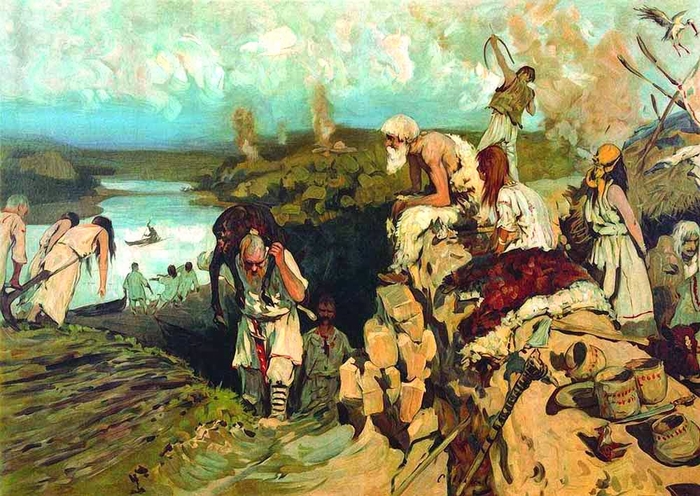
Social order and tribal unions
Initially, the Eastern Slavs lived in tribal communities, later they united into tribes. The development of production, the use of draft power (horses and oxen) contributed to the fact that even a small family could cultivate their allotment. Family ties began to weaken, families began to settle separately and plow new plots of land on their own.
The community remained, but now it included not only relatives, but also neighbors. Each family had its own piece of land for cultivation, its own tools of production and the harvest. Private property appeared, but it did not extend to forests, meadows, rivers and lakes. The Slavs shared these benefits.
In the neighboring community, the property status of different families was no longer the same. The best lands began to be concentrated in the hands of the elders and military leaders, and they also got most of the booty from military campaigns.
At the head of the Slavic tribes began to appear rich leaders-princes. They had their own armed detachments - squads, and they also collected tribute from the subject population. The collection of tribute was called polyud.
The 6th century is characterized by the unification of Slavic tribes into unions. The most powerful militarily princes led them. Around such princes, the local nobility gradually strengthened.
One of these tribal unions, as historians believe, was the union of the Slavs around the Ros (or Rus) tribe, who lived on the Ros River (a tributary of the Dnieper). Later, according to one of the theories of the origin of the Slavs, this name passed to all the Eastern Slavs, who received the general name "Rus", and the whole territory became the Russian land, or Rus.
Neighbors of the Eastern Slavs
In the 1st millennium BC, the Cimmerians were neighbors of the Slavs in the Northern Black Sea region, but after a few centuries they were supplanted by the Scythians, who founded their own state on these lands - the Scythian kingdom. Later, the Sarmatians came from the east to the Don and the Northern Black Sea region.
During the Great Migration of Nations, the East German tribes of the Goths passed through these lands, then the Huns. All this movement was accompanied by robbery and destruction, which contributed to the resettlement of the Slavs to the north.
Another factor in the resettlement and formation of Slavic tribes was the Turks. It was they who formed the Turkic Khaganate on the vast territory from Mongolia to the Volga.
The movement of various neighbors in the southern lands contributed to the fact that the Eastern Slavs occupied territories dominated by forest-steppes and swamps. Communities were created here that were more reliably protected from alien raids.
In the VI-IX centuries, the lands of the Eastern Slavs were located from the Oka to the Carpathians and from the Middle Dnieper to the Neva.

nomad raids
The movement of nomads created a constant danger for the Eastern Slavs. Nomads seized bread, livestock, burned houses. Men, women and children were taken into slavery. All this required the Slavs to be in constant readiness to repel raids. Every Slavic man was also a part-time warrior. Sometimes the land was plowed by armed men. History shows that the Slavs successfully coped with the constant onslaught of nomadic tribes and defended their independence.
Customs and beliefs of the Eastern Slavs
The Eastern Slavs were pagans who deified the forces of nature. They worshiped the elements, believed in kinship with various animals, and made sacrifices. The Slavs had a clear annual cycle of agricultural holidays in honor of the sun and the change of seasons. All rituals were aimed at ensuring high yields, as well as the health of people and livestock. The Eastern Slavs did not have a single idea of \u200b\u200bGod.
The ancient Slavs did not have temples. All rituals were performed at stone idols, in groves, in glades and in other places revered by them as sacred. We must not forget that all the heroes of the fabulous Russian folklore come from that time. Goblin, brownie, mermaids, water and other characters were well known to the Eastern Slavs.
In the divine pantheon of the Eastern Slavs, the leading places were occupied by the following gods. Dazhbog is the god of the Sun, sunlight and fertility, Svarog is the blacksmith god (according to some sources, the supreme god of the Slavs), Stribog is the god of wind and air, Mokosh is the female goddess, Perun is the god of lightning and war. A special place was given to the god of the earth and fertility Veles.
The main pagan priests of the Eastern Slavs were the Magi. They performed all the rituals in the sanctuaries, turned to the gods with various requests. The Magi made various male and female amulets with different spell symbols.
Paganism was a clear reflection of the occupations of the Slavs. It was the worship of the elements and everything connected with it that determined the attitude of the Slavs to agriculture as the main way of life.
Over time, the myths and meanings of pagan culture began to be forgotten, but much has come down to our days in folk art, customs, and traditions.
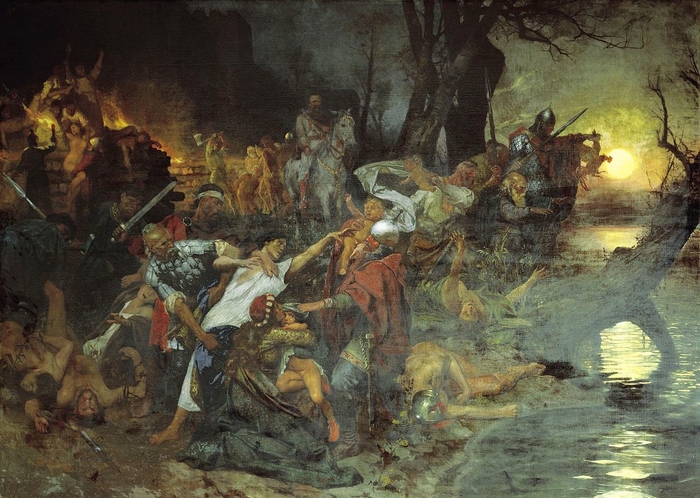
- In contact with 0
- Google+ 0
- OK 0
- Facebook 0

